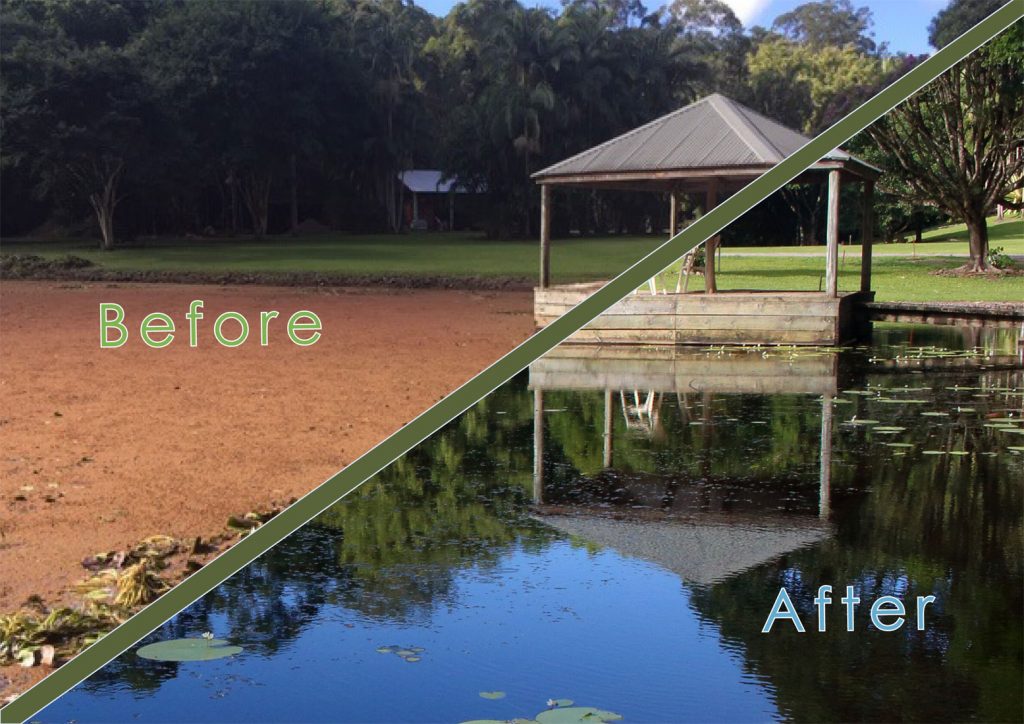
Wastewater Lagoon in Queensland.
This 1-hectare lagoon had very high Blue green algae (BGA) levels of 3 million BGA cells/mL before dosing began in March.
Ten weeks later the bloom was under control with ~9,000 BGA cells/mL and continues to remain the same with regular automated Diatomix dosing.
Prior to Diatomix dosing, aerators were being used to try and control the algae. After dosing started the aerators were turned off, and the power savings from lower power use are greater than the cost of the Diatomix dosing.

Stormwater Management
Councils often have lakes and ponds throughout their cities that are designed for managing stormwater when it rains. These same waterbodies are used by many people for recreational activities. When the water is full of toxic algae and weeds it is unusable.
This 25-hectare Lake in Victoria is treated with Diatomix to stop BGA blooms and improve the quality of the water as well as the aesthetic appearance of the Lake. Without problem blooms Councils don’t have to spend time and money with weed harvesting and erecting signs and barriers to advise of blue green algae issues.

Drinking water
Water reservoirs that store our drinking water can often be susceptible to blue-green algae blooms and many of them can be toxic. The types of treatment that can be used to manage this are very limited because of the safety considerations relating to drinking water treatment and the Australian Drinking Water Guidelines.
Diatomix is safe to use in these reservoirs because it does not contain any poisons, it simply supports the type of algae that are best for improving water quality, diatoms.

Garden ponds and dams
The domestic pond pictured had a history of various weed problems and filamentous algae.
The reactive approach prior to using Diatomix was to manually remove the unwanted weed which quickly grew back and came at a financial price and a cost to the delicate ecosystems within the pond and was often unsightly.
Diatomix treatment started in July and the photo shows the obvious improvement after only 12 weeks.
Barramundi farm in North Queensland

Blue-green algae blooms in fish farms can cause many problems including off-flavours in the fish. By treating a farm’s ponds with Diatomix the Microcystis and other BGA reduce, with water also being more oxygenated.
Ammonia reduction and lower nitrate levels also reduce the issues around clogging weeds and string algae. Farm operations and water quality all improve with Diatomix use.
Wetlands treatment

Wetland areas have a lot of biodiversity and Diatomix treatment increases that diversity. This site had issues with filamentous algae, Azolla and Salvinia blocking the outlet drains, adding unwanted plant biomass and generally causing poor performance in the wetland. Diatomix treatment showed quick results with Azolla and Salvinia dying back within 2 to 4 weeks and filamentous algae also dropping back.
After three months the increases in aquatic and bird life were being seen and the wetland has continued to improve. Because the nutrients circulating through the wetland are taken up by diatom algae the wetland will not overgrow in plants as quickly. Where wetlands are used for treatment systems, they will not need resetting as often as the reed and macrophyte growth is limited.